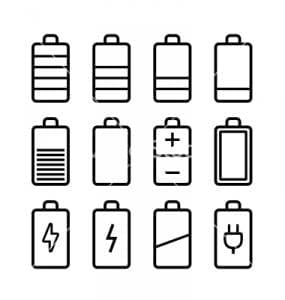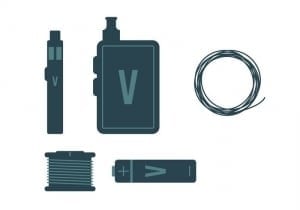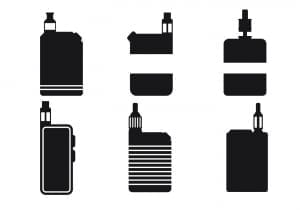Introduction
Vaping safe is something that is often discussed, and an important factor to consider is vape battery safety. This is definitely something not to overlook, but it often is. In this article, we will cover why battery safety in vaping is so important, and all of the aspects to consider when caring for your batteries.
Battery safety has become a more popular topic as of late, especially with more and more people vaping with lower resistance atomizers. There are tons on the market, especially 18650 batteries, which is the type we commonly use in our vaporizers.
There are some that may have catchy designs or may sound like it would be the top option, but in reality, it all comes down to what is underneath the wrapping to determine if it really is a good option and if it would suit you in regards to how you vape.
In this article, we will go over most of the important factors you need to take into consideration when choosing which battery to use when vaping. We will give a recommendation for different styles of vaping. It is important to note that aside from picking the safest, there are other aspects that we will cover in order for you to vape safe when choosing the best vape battery.
How to Rewrap Your 18650 Battery

Here are some things to take into consideration for battery wraps:
- One aspect of safety that is extremely important, regardless of what type of battery you are using, is the condition of the wrap.
- Over time, when using 18650 batteries or any other, the battery wrap can become damaged. The wrap can tear, have a nick or scratch, peel off, or just become worn.
- It is important to understand that the wrap itself is extremely important as without one, it can cause a short circuit, which can often result in very terrible things such as venting, which is something we definitely want to avoid.
Avoiding Battery Wrap Tearing:
- To avoid your wrap from tearing, be sure to always insert your batteries into your device the right way, and not forcing them into a device.
- This is important because in some devices they can easily tear, or pull on the battery wrapping if it is not inserted a certain way.
- In other cases, some devices tend to do it over time to your battery, regardless due to you taking them in and out often.
- In addition, to help avoid this potential issue is to continuously monitor them, and just make sure that the wrappings are intact.
- Every time you go to take out your batteries, always pay attention to see if the wrapping is being pulled in any way, as this is a sign that you should try another way to remove them.
Important Aspects to Consider:
- The most important area to consider when discussing battery wrapping is the positive end. It is extremely important that the positive end wrappings are not damaged in any type of way.
- If your wrapping near the positive end of your battery is starting to tear, rip or peel, it is extremely important to either rewrap the battery or use a different set if the batteries are married.
- You are much more likely to cause a short if the wrapping by the positive end is damaged; therefore it is of high importance that you always monitor it, even though you should consider rewrapping your battery regardless if there is damage to the wrapping anywhere.
Rewrapping Your Batteries:
- It is extremely easy to rewrap your batteries. All you have to do is purchase pre-cut battery wraps, take off your old wrap, and use a heat source such as a heat gun or blow dryer to install the new wrap.
- It is important to note, that the positive insulator must be put the same way as when you received the battery. The insulator is often white in coor, and is located at the positive end.
- If you are afraid of rewrapping on your own, or not sure on how to do it, you can always search the internet, as there are many videos and guides that show you exactly how to rewrap batteries!
- In addition, you can go to your local Vape shop, where they usually charge a small fee to rewrap your battery!
General Battery Care

In this section, I will be going over general things you should do for your battery when caring for them. There are certain things you should and should not do with your batteries, and we will be going over them as well.
What Not to Do!
- Firstly, you will never want to keep your batteries in your pocket with spare change or anything metal, as this can certainly cause your battery to vent.
- If you do plan on taking them out with you and want to put them in your pocket or purse, put them inside of a case. Battery cases are only about $2, and can store up to 4 batteries at once.
- Generally, it is a good idea to keep your batteries within a case, or some sort of protection in any given circumstance, as this provides safety.
- In addition, do not leave them inside of your car, or in a very hot area. Very high temperatures can cause your batteries to vent as well, so it is important that you do not leave them in an area that you feel will get extremely hot.
- As mentioned previously, a great example of this is leaving your battery inside of your car. Your car can reach incredibly high temperatures, especially in the summer time, so please do avoid leaving them in your car.
- Lastly, it is important to never leave your batteries unattended, especially when you are charging them. Even though many people do this, it is important and the safest thing to do. You always want to be there, or in close proximity of your batteries when they are on the charger, just in case if something were to happen.
Marrying Your Batteries
Another aspect of safety is marrying your batteries and whether you should do it or not. The answer to this is that you should always marry your batteries if you plan on using them together in devices.
Here is some general information about marrying your batteries:
- According to Mooch, it is recommended to marry the batteries, but once they are married you can use them in any other device regardless if configured in series or parallel.
- An example of this is using a set of 2 married batteries in one regulated box mod configured in parallel, and using the same set in another regulated box mod where the battery configuration is wired in series.
- Many new products and products as of late have utilized more than one battery; therefore this is an important aspect to discuss. Once you have your them married, you can use them on any other device, as long as they are discharged and charged at the same time.
- An easy way to track this is to just mark them using a pen marker, which is something I personally do to keep track of all my married and unmarried batteries.
- If you plan on not using the married set of batteries anymore, they cannot be used together again. An example of something different though, is that if you have a set of 3 married batteries and you want to separate one of them to be used alone, you surely can.
- The single battery that is being used alone is no longer married, but the other two batteries are still considered married and can be used together without any worries since they have been discharged and charged together previously.
- Once you do separate the other battery from the married set of 3, it is not recommended to use them together once again as a set of 3. This rule would apply similarly to married sets of 4 or more batteries as well.
Amps
Amps is another extremely important factor when discussing vape battery safety as different batteries has different ratings; therefore it is crucial to understand what limits each is capable of in order to choose which battery would suit your vaping style.
There are many batteries that are on the market today that often show the wrong rating, and sometimes even flat out lying about the amps that they can handle. Hence is why it is important to always purchase authentic batteries from reputable sources.
Battery Limits:
- Now, when speaking about amp limits of batteries many people confuse the continuous discharge rating to the pulsing discharge ratings. One of the main reasons as to why is what was said previously about misleading information on the battery wrappings.
- To be on the safest side possible, you will always want to stay within the continuous discharge rating, often known as CDR.
This topic is crucial in battery safety, and in vaping safe overall, because choosing which battery is important in regards to how you vape.
Also, it is important to know ohms law, because this is what directly impacts the number of amps you are pulling from the power source.
The lower your atomizer resistance, and the higher wattages you vape impacts the number of amps you draw, so this is crucial when building your own coils, or choosing replacement coil heads, and choosing which batteries suit your vaping style.
Mooch’s Data:
- Mooch was kind enough to do tons of testing to show us the true ratings of each battery that he has tested. Trust us, Mooch definitely knows his way on how to test 18650 battery.
- Thanks to him, and his testing, we are now able to more accurately choose which batteries to use when vaping. Of course, which is the right one depends on how you personally vape.
- In addition, Mooch has added Max Vaping Amps within his chart to show us what each battery can be pulsed to without severely damaging it.
- It is important to note, that within his testing if one was to push battery limits, it can often damage it and cut down its life cycle. It is still smart to always stay within the battery’s CDR rating.
If you are someone who vapes at higher wattages, batteries such as the Sony VTC4 or LG HB6 would be great since they have a higher continuous discharge rating, but this is something we will get more into later on within this article.
Lastly, it is important to understand each battery, especially the ones you plan on using as you want to choose what makes sense for you, and what is considered the safest, which leads me into the next section, which is chemistry.
Battery Chemistry
There are many different battery chemistries, and it is important to know and understand each one, as some are safer than others. In Mooch’s testing, he goes over the different battery chemistries, and which are considered the safest, and which is considered the least safe.
It is important to note, that any battery can vent in certain circumstances, but understanding which are less prone to violent reactions is important when choosing which batteries to use when vaping.
List of Battery Chemistries:
- Firstly, the safest is the IFR chemistry, which is described as a Lithium-Ferrous-Phosphate (LFP) Chemistry. These types of batteries have a much less violent reaction in comparison to other chemistries.
- The next battery chemistry on the list that is a little less safe than IFR is IMR batteries. These are Lithium-Manganese-Oxide (LMO) Chemistry, and have a less violent reaction and usually no flames.
- The next battery chemistry on the list is INR, which are a little less safe than IMR. These are often Nickel-Manganese-Cobalt (NMC), Lithium-Cobalt-Aluminum (LCA), and Nickel-Cobalt-Aluminum (NCA) chemistries. INR batteries are considered a “hybrid” chemistry, and most have a combination of materials and characteristics of both IMR batteries and ICR batteries. This is overall a safe chemistry, even though not as safe as the other two mentioned.
- The last chemistry on this list is the ICR chemistry. These are considered the least safe and are Lithium-Cobalt-Oxide (LCO), which is the same chemistry as LiPo. These can go into thermal runaway easier than the previous chemistries and are often much more violent.
Here’s a quick video explaining more about this
https://www.youtube.com/watch?v=Qd0FpGFyAbs
Battery Safety in Mechanical Mod

Even though the majority of vapers tend to use regulated mods, there are still many vapers who still use mechanical mods, or there are vapers who are interested in using these types of devices.
Battery safety and ohms law are crucial when operating this type of device since there are no protection features like you would find on a regulated device.
With a mechanical device, the amount of amps you are pulling from your batteries depends on the resistance of your attached atomizer; therefore it is important that you understand ohms law and battery safety as they go hand-in-hand with one another.
Parallel
- For example, if you have a resistance of 0.1 ohm on your atomizer, the amount of amps you will draw is 42. Now on a single mechanical mod, this is definitely exceeding any battery’s CDR, and can be seen as unsafe.
- Now if you take into consideration a parallel mechanical mod where it utilizes 2 batteries, it will give you double the capacity and 1.5 the amount of amps, which is much safer in comparison.
- Now there is a debate about whether or not a parallel mechanical mod would give you double the amount of amps, but for safety reasons I will say you will get 1.5 the amount of amps from this type of setup. An example of this would be if you are using two 20A CDR batteries, you will get a CDR of 30A; therefore you will be safer when building lower on these types of devices.
Series
- In a series configuration, you will not be getting 1.5 the amount of amps nor double the capacity due to a series configuration. However, you are getting 8.4v rather than 4.2v, which would be getting from a parallel configuration.
- It is even more important to understand ohms law in this configuration, as you need to build your coils completely differently due to the amount of volts
- An example of how it differs is as follows: an atomizer with a resistance of 0.5 ohm will draw 16.8A from your batteries, whereas in a parallel configuration, a resistance of 0.5 ohm will draw only 8.4A.
- By seeing this example, you can see how in a series configuration the amount of amps you will draw from you batteries is completely different with the same resistance atomizer; therefore proving that understanding ohms law and battery safety is crucial with these types of devices.
Battery Safety in Regulated Mods

Now in a regulated box mod, it is completely different on how to calculate how much amps you will draw. To simplify this, I will use Mooch’s data as reference.
According to Mooch’s safety charts, to calculate the max amps, you simply divide the max wattage by the minimum voltage per battery.
The formula can be seen as this:
- Max Amps Per Battery = Max Wattage Per Battery / Minimum Voltage Per Battery
An example of how to calculate this is also taken from Mooch’s data, and is as follows:
- With a 150w box mod with a maximum voltage output of 6.4v, you can calculate the max amps by using this formula:
- Max Amps Per Battery = 75w (150w maximum output / 2 batteries) / 3.2v (6.4 max volts/ 2 batteries) = 23.4A Max Amps Per Battery at 150w
As shown with this example, in order to use this device at its maximum wattage you will need a battery capable of 23.4A of current.
So depending on the amount of wattage you plan on vaping at, or the amount of power and voltage provided by a selected device can determine which batteries are right for you in regards to a regulated device.
Rewrapped 18650 Batteries
Before getting to recommendations, this section is important as there are many batteries on the market that give false ratings, and are just rewraps of other batteries. Many companies like Efest, Imren and MXJO offer rewrapped batteries.
In Mooch’s testing, you can see the batteries that are tested, and he goes over each and tells you whether or not it is a rewrap, and tells you which battery it truly is.
My personal recommendation is to buy batteries from bigger companies who actually manufacture their batteries such as LG, Samsung, Panasonic and Sony. The reason why is that many of the batteries offered on the market that are not these brands are often rewraps of the batteries those companies manufacture.
Now there are other companies who do manufacture their own batteries, but those there that are mentioned offer batteries that vapers often use in their devices.
My thought on this is why purchase a rewrap when you can just buy it from one of these said companies, and know exactly which battery you are getting. In some cases, some batteries claim much higher ratings than what they are actually capable of; therefore putting you, the vaper at risk.
So it is important and recommended that you check out Mooch’s tests as he goes over brands such as Efest and MXJO, and tell you their true ratings, and what battery they possibly can be. So in the future, if you do decide to purchase batteries that are rewrapped, at least you have a source where you can go to, to check out their true ratings (if Mooch has tested them).
Conclusion
In conclusion, battery safety is surely a big topic of discussion, and it is an important factor to take into consideration when vaping. Safety should be one of the most important factors in vaping, as these are what power our devices for us to actually vape.
Many things can certainly go wrong if someone was to misuse, or not care for a battery like it’s supposed to be. With this article, we give you information about understanding how much amps you are pulling in both unregulated mods and regulated mods.
In addition, we do cover briefly the difference between parallel and series configurations, as it is important to understand the major difference in the amps drawn based upon your atomizer resistance.
You will always want to be safe with your batteries, as you do not want them to vent as they can certainly damage your device, or cause you bodily harm.
Understanding battery safety at first can surely be intimidating, but hopefully, with this article, you can understand more about it in general, and do the right things in regards to caring for them.
Thankfully, we have Mooch and his charts which gives us great advice and information in regards to battery safety. With his link, you can check out many tests in various sizes, as well as tons of other useful information and recommendations.
Battery Safety isn’t something that should be taken lightly. It is important to care for them. Simple mistakes can lead to DISASTROUS outcomes, so always take care. And check out our main article for more on vaping safety.
Clicking that link there will take you to our Vaping: 101, The Beginners Guide To Vaping article. In this article you will find useful information about vaping, the benefits of switching to vaping, what is e-liquid, and much more!
Knowing and understanding all of the information given in these articles will prepare you for the start of your vaping experience! So whether you want to know more about vaping or wanting to see what are some of the options available to start off with, these articles will guide you down the right path!
Lastly, I would also like to thank Mooch again for all the great work he has been doing for us vapers. If you have any questions or comments, feel free to leave them below!
With the information in this article, I hope it informs you more about battery safety and gives you a better understanding overall about the batteries we use for vaping.
